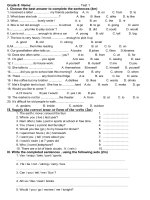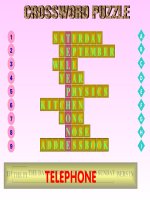ENGLISH 8 UNIT 1 MY FRIENDS PERIOD 4-6 WRITE LANGUAGE FOCUS UNIT 2 GS L&R
Bạn đang xem bản rút gọn của tài liệu. Xem và tải ngay bản đầy đủ của tài liệu tại đây (322.77 KB, 13 trang )
<span class='text_page_counter'>(1)</span><div class='page_container' data-page=1>
<i><b>Date of planning: 10/9/2020 </b></i>
<b> Period :4</b>
<b>UNIT 1: MY FRIENDS</b>
<b>LESSON 4: WRITE </b>
<b>A.The aims of the lesson</b>
<b> 1. Knowledges</b>
<b>+ The aims: By the end of the lesson, ss will be able to write a paragraph about their </b>
close friends. Write a short paragraph about oneself and other people
- Vocabulary: character (n);orphanage (n); sense of humor ; joke (n); annoy (v);
sociable (adj); generous (adj); outgoing (adj) = easy going (adj); kind (adj);
reserved (adj); hard-working (adj)
- Structures : - Present simple
<b> 2. Skills : - Practice the comprehension reading skill, listening skill.</b>
<b> 3. Attitude: - Help ss to have good consciousness in order to write a paragraph about</b>
their friends. Learn hard, love their friends, and conserve their friendship
<b>B. Preparations</b>
1.Teacher : posters, computer, Lesson plan, textbooks, pictures, speaker, projector.
2. Students: Unit 1 Write
<b>C. Methods: - Model-Talk-Practice, individual work, group work</b>
- Some techniques can be used: Matching, filling, Q & A
<b>D. Procedure :</b>
<b>I.Organization: ( 1 minute)</b>
<b>-</b> Greeting: Good morning!
<b>-</b> Who’s absent today?
<b>Class</b> <b>Date of teaching</b> <b>Absent students</b>
<b>8A</b> <b>15/9</b>
<i><b>II. Review of the previous lesson(5’)</b></i>
Ss read the text about Ba and his friends (p. 13)
Ss answer these questions:
<i>+ How does Ba feel having a lot of friends? (He feels lucky having a lot of friends).</i>
<i>+ Who is the most sociable? (Bao is the most sociable). </i>
<i>+ Who likes reading? (Khai likes reading).</i>
<i>+ What is the bad thing about Ba's jokes? (His jokes sometimes annoy his</i>
<i>friends).</i>
<i>+ Where does Bao spend his free time? (Bao spends his free time doing</i>
<i>volunteer work at a local orphanage)</i>
<i>III. New lesson</i>
<b>Teacher’s activities</b> <b>Ss’ activities</b>
</div>
<span class='text_page_counter'>(2)</span><div class='page_container' data-page=2>
_T asks Ss to play game
- Ss play game
<b>1. Pre-writing(10’)</b>
- New words
+ Humorous (a)
+ short (a)
+ slim (a)
+ sociable (a)
+ revered (a)
-Check
1.Read the information aboutTam
- T lets Ss read the paragraph about Tam
- T asks Ss some questions
- T has Ss remind the words about
appearance, character
- T lets Ss practice (ask and answer about
personal information)
<b>2.While-writing(16’)</b>
- Fill in a similar form for your partner
- T asks Ss to write a paragraph about their
partner
- Ss write
Group work/Pair work
- T asks some Ss to write their paragraphs
on the board
- Ss write
- T corrects Ss’ mistakes
<b>3. Post-writing(10’)</b>
- Write a short paragraph about themselves
-Ask some Ss to speak in front of the class
about himself/ herself
A B
Name Tall
Age Humorous
Description 14
Character Nam
Address 12 Le Loi street
<b>New word:</b>
- Ss listen and repeat
1.
Read the information about Tam
and answer some questions
Ex: What’s his name?
How old is Tam?
Where does he live?
What does he look like?
Who does he live with?
- Ss answer
2.
Fill in a similar form for your
partner. Use the following questions
as prompts .
Ex:
Name: Nguyen Thi Mai Age:14
Appearance: tall, long black hair
Characters: sociable, kind
Address: 30 Tran Phu street.
Family: Father, mother, younger
sister, Lan
Friends: Minh, Tam
: Now write a paragraph about your
partner ( Marks )
<b> Ss’writing:</b>
</div>
<span class='text_page_counter'>(3)</span><div class='page_container' data-page=3>
3.Write a short paragraph - speak
<i><b>IV. Summary(1’)</b></i>
Write about themselves and other people.
<i><b>V. Homework:(2’)</b></i>
- Learn by heart the new word.
- Do exercise 7/11
- Write another paragraph about one of their family members
- Prepare Language focus (page 16)
<b>*Evaluation:</b>
………
………
………
Reliable (đáng tin cậy ), ambitious(có hồi bão ), bright(sáng dạ ), decisive(dứt
khốt ) /di’saisiv/, genuine (thành thật ) /juin/, humblemodest (khiêm tốn ), sensible
(khôn ngoan ), arrogant ( kiêu), neglect ( ), obedient(ngoan ), bad-tempered( nóng
tính), cheerful, patient, easygoing, brave
</div>
<span class='text_page_counter'>(4)</span><div class='page_container' data-page=4>
<b> Period: 5</b>
<b>UNIT 1: MY FRIENDS</b>
<b>LESSON 5: LANGUAGE FOCUS</b>
<b>A.The aims of the lesson</b>
<b> 1. Knowledges</b>
<b>+ The aims: By the end of the lesson, ss will have a good chance to review: </b>
- The present and past simple tense (irregular verbs)
- The present simple to talk about general truths
- “be (not) + adj + enough + to – infinitive”
<b>Ask and answer the questions using the past simple tense </b>
2. Skills: - listening, reading, speaking, writing skill.
- Vocabulary:
- Structures : The past simple or present simple
S + be(not) + adj + enough + (for + O) + V ( to- inf )
<b> 3. Attitude: Help ss to have good consciousness in order to review the words and </b>
structures. To learn hard and to be friendly.
<b>B. Preparations</b>
1.Teacher : posters, computer, Lesson plan, textbooks, pictures, speaker, projector.
2. Students: Unit 1 Language focus
<b>C. Methods: - Model-Talk-Practice, individual work, group work</b>
Some techniques can be used: Kim’s game, word cue drill, filling, Q & A
<b>D. Procedure :</b>
<b>I.Organization: ( 1 minute)</b>
<b>-</b> Greeting: Good morning!
<b>-</b> Who’s absent today?
<b>Class</b> <b>Date of teaching</b> <b>Absent students</b>
<b>8A</b> <b>18/9</b>
<b>II. Warm up: Kim’s game </b>
-Ask ss to look at the picture ( p 17) for 20 seconds – Close the books – 4 groups
answer the qts, the group which answer correctly the fastest wins the game.
a, How many people are there in the picture? 4
b, What is each person wearing?
-The woman is wearing a red shirt and a green skirt.
- The man who is standing beside the car is wearing brown trouser and a yellow shirt.
- The man who is standing on the pavement is wearing a pink shirt and blue trousers.
- The boy is wearing blue shorts and white shirt.
</div>
<span class='text_page_counter'>(5)</span><div class='page_container' data-page=5>
<b>Teacher’s activities</b> <b>Students’ activities</b>
<b> 1. Presentation</b>
1.Vocab:
-Elicit – model – repeat – copy – check
( meaning, stress)
+ planet (ex: the sun, the moon, the earth
… . What are they?)
+ Mars
+ Mercury
+ silly (adj)
- Check R & R
2. Reminding the rules of past and present
tenses.
- Ss notice and do exercises
<b>2. Practice</b>
- T has Ss complete the paragraphs(pair
work)
- T asks Ss to compare their answers with
their partners
- T asks Ss to give the answers
- Ss give the answers
- T corrects Ss’ mistakes.
- T reminds students note the adverbs that
are used in present simple, past simple
- T has Ss practice the dialogue (pair work)
- T asks Ss to compare their answer with
their partners
- T lets some pairs practice the dialogue
before the class.
- T corrects Ss’ mistakes
<b>1. Presentation</b>
<b>- Reminding the structure (not) adj +</b>
<b>enough + to inf. Then T. gives an example</b>
- Ss review the structure
<b>2. Practice</b>
* Word cue drill
Present: S + V(es/s) + O
Past : S + V(ed/…) + O
1.
<b> Complete the paragraphs. Use the</b>
correct form of the verbs in
brackets(8’)
a. 1. lives
2. sent
3. was
4. is
b. 1. are
2. came
3. showed
4. introduced
2.Complete the dialogue using the
correct form of the verbs in box. You
will have to use some verbs more
than one(7’)
- Ss compare their answers
</div>
<span class='text_page_counter'>(6)</span><div class='page_container' data-page=6>
A, Read English books/v good
-Can you read E books?
Yes, My E is good enough to read E books.
B, Drive a car/x old
-Can you drive a car?
No, I’m not old enough to drive a car.
C, Carry this bag/v strong.
- Can you carry this bag?
Yes, I’m strong enough to carry this bag.
D, Solve this problem/ x clever.
- Can you solve this problem?
No, I’m not clever enough to solve this
problem.
<b>3. Production</b>
- T has Ss do ex 4 ( 17) - practice the
dialogue
(pair work)
- T lets some pairs practice the dialogue
before the class.
- Give the similar dialogues
- T corrects Ss’ mistakes.
(6) is
4.Complete the dialogue use (not)
adjective + enough + to
infinitive(10’)
(b) Hoa: ………
Lan: …………Ba is not old
enough ………
(c) Hoa: ………
Lan: ……… I’m strong
enough …………
(d) Hoa: ………
Lan: ……… good
enough …………
<i><b>IV. Summary(1’)</b></i>
- The present and past simple tense (irregular verbs
- The present simple to talk about general truths
- “be (not) + adj + enough + to – infinitive”
<i><b>V.Homework(2’)</b></i>
- Do exercise 5 in exercise book (at p.9)
- Prepare: Unit 2 L1 (Getting Started + Listen and read )
<b> </b>
<b>*Evaluation:</b>
</div>
<span class='text_page_counter'>(7)</span><div class='page_container' data-page=7>
<b>1. Sun</b>
/sʌn/ Mặt Trời<b>2. Mercury</b>
/ˈmɜːrkjəri/ Sao Thủy<b>3. Venus</b>
/'vi:nəs/Sao Kim<b>4. Earth</b>
/ɜːθ/ Trái Đất<b>5. Mars</b>
/mɑ:z/Sao Hỏa<b>6. Jupiter</b>
/'dʤu:pitə/SaoMộc
<b>7. Saturn</b>
/'sætən/Sao Thổ<b>8. Uranus /ju’rein s/</b>
Sao Thiên Vương<b>9. Neptune</b>
/'neptju:n/Sao Hải VươngTên tiếng Anh của các châu lục: Châu Á, Châu Âu, Châu Mỹ, Châu Phi, châu Đại Dương, châu Nam Cực là gì
các đại dương trong tiếng Anh
Chúng ta thường nghe câu: cường quốc năm châu, năm châu bốn biển. Vậy thực tế chúng ta có bao nhiêu châu
lục. Câu trả lời là tùy vào địa lý chia. Thông thường 5 châu sẽ bao gồm: Châu Á, Âu, Mỹ, Phi, Đại dương. Còn
châu Nam Cực khơng được tính. Nếu tính là 6 châu sẽ có thêm châu Nam cực. Nếu tính là 7 châu thì châu Mỹ
sẽ chia ra làm 2 phần là Bắc mỹ và nam Mỹ.
Vậy tên tiếng Anh của các châu là gì nếu bạn thắc mắc có thể xem danh sách dưới đây
<b>Danh sách các châu lục trên thế giới</b>
Châu Á: Asia
Châu Âu: Europe
Châu Mỹ: America
Châu Phi: Africa
Châu Đại Dương: Australia
Châu Nam Cực: Antarctica
Bắc Mỹ: North America
Nam Mỹ: South America
<b>Các đại dương</b>
</div>
<span class='text_page_counter'>(8)</span><div class='page_container' data-page=8>
<b>Unit 2. Making arrangements</b>
<b>I. Objectives:</b>
<b>1. Topic: </b>
Friends
<b>2. Competences:</b>
- To talk about intentions.
- To use telephones to make and confirm arrangements
- To take a telephone message
<b>3.Skills:</b>
- Speaking: using telephones to make and confirm arrangements
- Listening: listen to the text and fill in the missing words.
- Reading: read passages about Alexander Bell’s invention
- Writing: write the telephone message
<b>4. Grammar:</b>
<b>-</b> Going to – to talk about intentions and activities in the future.
<b>-</b> Adverbs of place
<b>5. Vocabulary:</b>
<b>-</b> device, directory, deaf – mute…
<b>-</b> to conduct, to demonstrate. To transmit, to emigrate, to make an appointment, to
take a message
<b>II. Unit plan:</b>
<b>Unit 2: Making arrangements (6 periods)</b>
Period 1 : Getting started- Listen and read
Period 2: Speak
Period 3: Listen
Period 4: Read
Period 5: Write 1,2
</div>
<span class='text_page_counter'>(9)</span><div class='page_container' data-page=9>
<b>Date of planning: 10/9/2020 </b>
<b>Period: 6</b>
<b> </b>
<b>UNIT 2: MAKING ARRANGEMENTS</b>
<b>LESSON:1 GETTING STARTED & LISTEN AND READ</b>
<b>A.The aims of the lesson</b>
<b> 1. Knowledges</b>
<b>+ The aims: By the end of the lesson ss will be able to listen and read a dialogue </b>
between Hoa and Nga on the phone for general or detailed information. Ask and answer
more questions about the dialogue
+ Vocabulary: downstairs(adv) ; afraid(adj), outside (adv); arrange(v) ; agree(v);
fine(adj); use(v) ; of course.
+ Structures : - “ Can/ Could I speak/talk to …, please?
- Hold on…
- Is 6.30 all right?
- Let’s meet outside the theater.
<b> 2. Skill: - Practice the comprehension listening, reading skill, speaking skill.</b>
<b> 3. Attitude: Educating ss about the need to learn hard and to be polite on the phone</b>
<b>B. Preparations</b>
1.Teacher : posters, computer, Lesson plan, textbooks, pictures, speaker, projector.
2. Students: Unit 2 Getting started, listen and read.
<b>C. Methods: - Model-Talk-Practice, individual work, group work</b>
- Some techniques can be used: Asking and Answering, Matching, Open predictions
<b>D. Procedure :</b>
<b>I.Organization: ( 1 minute)</b>
<b>-</b> Greeting: Good morning!
<b>-</b> Who’s absent today?
<b> Class</b> <b>Date of teaching</b> <b>Absent students</b>
<b>8A</b> <b>19/9</b>
<i><b>Teacher’s activities</b></i> <b>Students’ activities</b>
<b>II.Warm up :(5’)</b>
T asks Ss to match each object (pictures
on page 18 ) with its name
- T gives the definitions of these objects
on a poster and ask Ss to match the
object with its definition
I. Getting started:
Matching:
Answers:
a. an answering machine
b. a mobile phone
c. a fax machine
</div>
<span class='text_page_counter'>(10)</span><div class='page_container' data-page=10>
<b>III. New lesson</b>
<b>1.Pre-reading (8’)</b>
<i><b>1.Vocabulary\</b></i>
<i><b>- arrange(v) – arrangement(n)</b></i>
- a bit far from
<b>2.Prediction.</b>
- T introduces the situation “Hoa and
Nga are talking on the phone. They are
talking about going to see a movie ”
- T asks Ss to guess.
- T gives feedback
<b>2. While- reading (15’)</b>
- T uses the cassette
- T explains new words/ phrases
-Ss practice the text with their partners.
-Ss read the text and check their
predictions.
- T gives some questions
<b>Questions (mark)</b>
1.What’s Hoa’s telephone number?
2. Which movie are they going to see?
Where?
3.How is Hoa going to see the movies?
4. Where are they going to meet? What
time?
e. a public telephone
f. an address book
Definition:
1. to send fax
2. to find someone’s telephone
number
3. to write address and telephone
numbers
4. to make a phone call in a street
telephone box
5. to leave and take messages
6. to make phone call anywhere you
like
Answers:
a - 5 d – 2 b - 6 e - 4
c - 1 f - 3
- Ss guess to answer the qts
- Ss listen to the tape
a. Who make the call?
b. Who introduced herself?
c. Who invited the other to the movies?
d. Who arranged a meeting place?
e. Who arranged the time?
f. Who agreed to the time?
- Compare with the partner
Answer (p/19)
</div>
<span class='text_page_counter'>(11)</span><div class='page_container' data-page=11>
T gives feedback
<b>3.Post- reading(8’)</b>
- T asks Ss to play the roles of two Ss
who are talking on the phone making
arrangement
- Ss: pair work
1.Her telephone number is 3 847 329
2.They are going to Sao Mai Movie
Theater.
3.She is going to see the movie by bike.
4.They are going to meet outside the
theater.
- Make arrangements on the phone
- go camping
- go fishing …
<i><b>IV.Summary(1’): </b></i>
Making the arrangements
<i><b>V. Homework: (2’)</b></i>
- Write a similar dialogue on your notebooks
- Learn by heart the dialogue & new words
<b> *Evaluation:</b>
</div>
<span class='text_page_counter'>(12)</span><div class='page_container' data-page=12>
<b>A. Các tính từ ở trong nhóm từ (a) đến (e) trên đều đứng trước danh từ. B. Tính từ chỉ phẩm chất</b>
<b>cũng có thể đứng trước danh từ</b>
Các loại tính từ
Tính từ + nguyên mẫu/mệnh đề that/giới từ
Than/ as + đại từ + trợ động từ (auxiliary)
The + tính từ với nghĩa số nhiều
Xem thêm: TÍNH TỪ (ADJECTIVES)
<b>A. Các tính từ ở trong nhóm từ (a) đến (e) trên đều đứng trước danh từ :</b>
This book (cuốn sách này), which boy (cậu con trai nào),
my dog (con chó của tơi).
Các tính từ ở vị trí này được gọi là tính từ thuộc ngữ (attibutive)
<b>B. Tính từ chỉ phẩm chất cũng có thể đứng trước danh từ: a rich man (một người giàu</b>
<b>có), a happy girl (một cơ gái hạnh phúc). Hay sau một động từ như (a) : be, become,</b>
<b>seem.</b>
Tom became rich (Tom đã trở nên giàu có).
Ann seems happy (Ann dường như sung sướng).
hoặc (b): appear (xuất hiện), feel (cảm thấy), get /grow (trở nên.), keep (giữ), look (trông),
make (làm), smell (ngửi), sound (nghe), taste (ném), turn (trở nên).
Tom felt cold (Tom cảm thấy lạnh),
He got / grew impatient (Anh ta trỏ nên nơn nóng).
He made her happy (Anh ta đã làm cô ta sung sướng).
The idea sounds interesting (Ý kiến nghe hay đấy).
Những từ ở vị trí này được gọi là tính từ vị ngữ (predicetive), những động từ dùng ở cách
này được gọi là động từ nối (link verbs ) hay động từ giao hợp (copulas).
<b>C. Lưu ý về động từ nối (xem 169).</b>
Một rắc rối về cách dùng các động từ ở B (b) trên là khi chúng không được dùng như là
động từ nối thì chúng vẫn có thể được bổ nghĩa bởi những trạng từ theo cách dùng quen
thuộc. Điều này làm những người học tiếng Anh lúng túng vì đa số thường dùng trạng từ
thay vì dùng tính từ sau các động từ nối. Sau đây là một số ví dụ về sự khác nhau trong
cách dùng trạng từ và tính từ :
He looked calm tính từ (Anh ta trơng điềm tĩnh).
He looked calmly (trạng từ) at the angry crowd .
(Anh ta điềm tĩnh nhìn vào đám đơng giận dữ).
She turned pale (tính từ): cơ ta trở nên xanh xao).
He turned angrily (trạng từ) to the man behind him. (Anh ta trở nên giận dữ với nguời đàn
ông đứng sau anh ta>
</div>
<span class='text_page_counter'>(13)</span><div class='page_container' data-page=13>
He tasted the soup suspiciously (trạng từ)
(Anh ta nếm súp một cách nghi hoặc).
<b>D. Một số tính từ chỉ có thể được dùng là tính từ thuộc ngữ hay tính từ vị ngữ và một</b>
<b>số thay đổi ý nghĩa của chúng khi dời từ vị trí này sang vị trí khác.</b>
bad / good (xấu/tốt), big / small (lớn/nhỏ), heavy / light (nặng /nhẹ), và old (cũ, già) dùng
trong những thành ngữ như thế này là : bad sailor (thủy thủ tồi), good swimmer (tay bơi lội
giỏi), big eater (người ăn nhiều), small farmer (chủ trại nhỏ) heavy drinker (người nghiện
rượu nặng), light sleeper (người tỉnh ngủ), oldboy/friend/soldier (cậu con trai xưa / bạn cũ
/người lính già) v.v... không thể được đùng một cách khẳng định mà không thav đổi ý nghĩa:
a smell farmer (một chủ trại nhỏ) nhưng the farmer is small (người chú trại thì nhỏ con).
Trong các cách dùng khác, các tính từ trên có thế ở cả hai vị trí. (Với little, old, Young xem
19 B).
chief (chủ yêu), main (chính), principal (chủ yếu), sheer (hoàn toàn, tuyệt đối), utterr (hoàn
toàn) đều đứng trước danh từ.
— frightened (hoảng sợ, khiếp sợ) có thể có hai vị trí, nhưng afraid (e sợ) và upset (khó
chịu) phải đứng sau động từ. Vì thế các từ adrift (lênh dênh), a float (lênh đênh, bềnh bồng),
alike (giống, tương tự) (xem 21 G), alive (cịn sống),alone (cơ dơn), ashamed (hổ thẹn),
asleep (đang ngủ) cũng phải theo cách này.
— Nghĩa của early (sớm) và late (muộn) có thế tùy thuộc vào vị trí của chúng : an carly /a
Inte train (một chuyến xe lừa sớm/muộn) [câu này có nghĩa là chuyến xe lửa chạy đúng lịch
trình là sớm hay muộn trong ngày] còn the train is early / laite (xe lửa đến sớm / muộn) [câu
này có nghĩa là xe lửa đến sớm hay muộn theo giờ ấn định].
— poor (nghèo)có thể đặt trước danh từ hay sau động từ.
—poor (đáng thương) phải đặt trước danh từ.
—poor (yếu, kém) đứng trước danh từ như student (học sinh), work (công nhân).. v..v nhưng
khi dùng với những danh từ vơ sinh thì có thể đứng ở cả hai vị trí:
He has poor sight (Anh ta có thị lực kém).
His sight is poor (Thị lực của anh ta thì kẽm)
<b>E. Cách dùng của and.</b>
Với những tính từ thuộc ngữ thì and (và) được dùng chủ yếu khi có hai hay nhiều tính từ chỉ
màu sắc và được đặt trước tính từ cuối.
a green and brown carpet (một tấm thảm xanh và nâu).
a red, white and blue flag (một lá cờ đỏ, trắng và xanh).
Với những tính từ vị ngữ thì and được đặt giữa hai từ cuối
</div>
<!--links-->
English 8- UNIT 4 GS-Listen & read
- 20
- 1
- 1








